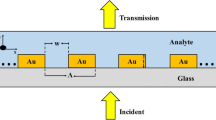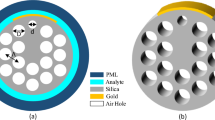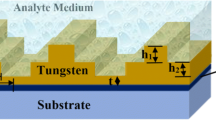Abstract
This paper reports an advanced and novel sensing idea by utilizing the concept of surface plasmon resonance. A numerically designed model of plasmonic-based sensor has been proposed that is capable of detecting the mixture of water in alcohol and in a variety of other electrolytes including milk, hemoglobin, octane, etc. The sensor uses gold as a recognition element with equidistant slits for the transmission of incoming light which give rise to plasmon polaritons on metal–dielectric–interface. The zeroth-order transmission spectra have been extracted for this investigation and optimization. A transverse magnetic wave illuminates the noble metal normally through a glass substrate generating surface plasmon polaritons (SPPs) on a particular wavelength which changes with respect to the refractive index of adjacent medium. The sensor model has been numerically solved after optimization of slit size by keeping other parameters fixed utilizing the fundamental plasmonic mode for efficient excitation of SPPs. In this sensing chip, a uniform spatial period of about 660 nm, a constant slit size of 320 nm, a gold thickness of 50 nm for sensing element and 500 nm for glass substrate are used. An appreciable increment in the value of refractive index sensitivity of 668.66 nm per RIU has been found which is noteworthy. Such sensors are likely been welcomed in biological investigation, along with chemical and environmental detection techniques.







Similar content being viewed by others
References
Camley R, Mills D (1984) Collective excitations of semi-infinite superlattice structures: surface plasmons, bulk plasmons, and the electron-energy-loss spectrum. Phys Rev B 29(4):1695
Chiavaioli F et al (2017) Towards a uniform metrological assessment of grating-based optical fiber sensors: from refractometers to biosensors. Biosensors 7(2):23
Dai Y et al (2018) Experimental demonstration of high sensitivity for silver rectangular grating-coupled surface plasmon resonance (SPR) sensing. Opt Commun 416:66–70
Gauglitz G (1996) Opto-chemical and opto-immuno sensors. Sensors Update 1(1):1–48
Grande M et al (2011) Asymmetric plasmonic grating for optical sensing of thin layers of organic materials. Sens Actuators, B 160(1):1056–1062
Guillaumée M, Dunbar LA, Stanley RP (2011) Description of the modes governing the optical transmission through metal gratings. Opt Exp 19(5):4740–4755
Homola J (2003) Present and future of surface plasmon resonance biosensors. Anal Bioanal Chem 377(3):528–539
Homola J (2006) Electromagnetic theory of surface plasmons. Surface plasmon resonance based sensors. Springer, Berlin, pp 3–44
Homola J, Piliarik M (2006) Surface plasmon resonance (SPR) sensors. In: Homola J (ed) Springer series on chemical sensors and biosensors. Springer, Berlin
Homola J, Yee SS, Gauglitz G (1999) Surface plasmon resonance sensors. Sens Actuators, B 54(1–2):3–15
Hong M et al (2012) Resonance in a sub-wavelength metal-dielectric free-standing grating utilized for gas sensors. Opt Commun 285(24):5480–5485
Iqbal T (2015) Propagation length of surface plasmon polaritons excited by a 1D plasmonic grating. Curr Appl Phys 15(11):1445–1452
Iqbal T, Afsheen S (2016a) Coupling efficiency of surface plasmon polaritons for 1D plasmonic gratings: role of under-and over-milling. Plasmonics 11(5):1247–1256
Iqbal T, Afsheen S (2016b) Plasmonic band gap: role of the slit width in 1D metallic grating on higher refractive index substrate. Plasmonics 11(3):885–893
Iqbal T, Afsheen S (2017) One dimensional plasmonic grating: high sensitive biosensor. Plasmonics 12(1):19–25
Iqbal T et al (2019) An optimal Au grating structure for light absorption in amorphous silicon thin film solar cell. Plasmonics 14(1):147–154
Li H, Lin L, Xie S (2000) Refractive index of human whole blood with different types in the visible and near-infrared ranges. In Laser-tissue interaction XI: photochemical, photothermal, and photomechanical. International Society for Optics and Photonics
Maier SA (2007) Plasmonics: fundamentals and applications. Springer, New York
McMullen P, Ziegler GM (1996) Lectures on polytopes (Graduate Texts in Mathematics, Vol. 152, Springer-Verlag, Berlin-Heidelberg-New York-London-Paris-Tokyo-Hong Kong 1995), ix + 370 pp., softcover: 3 540 94365 X,£ 21, hardcover: 3 540 94329 3,£ 47. Proc Edinburgh Math Soc 39(1):189–190
O’Brien RN, Quon D (1968) Refractive index of some alcohols and saturated hydrocarbons at 6328 A. J Chem Eng Data 13(4):517–517
Palik ED (1985) Handbook of optical constants of solids. Academic Press, Orlando, pp 286–297
Piliarik M et al (2012) High-resolution biosensor based on localized surface plasmons. Opt Exp 20(1):672–680
Polyanskiy M (2014) RefractiveIndex. info. MediaWiki. http://refractiveindex, p. 10
Rabbany SY et al (2000) Trace detection of explosives using a membrane-based displacement immunoassay. J Immunol Methods 246(1–2):69–77
Radhakrishnan R, Poltronieri P (2017) Fluorescence-Free Biosensor Methods in Detection of Food Pathogens with a Special Focus on Listeria monocytogenes. Biosensors 7(4):63
Rangappa K (1947) Studies on the refractive index of milk. In Proceedings of the Indian Academy of Sciences Section B. Springer
Rosen JS (1947) The refractive indices of alcohol, water, and their mixtures at high pressures. JOSA 37(11):932–938
Rowe-Taitt CA et al (2000) Simultaneous detection of six biohazardous agents using a planar waveguide array biosensor. Biosens Bioelectron 15(11–12):579–589
Touhami A (2014) Biosensors and nanobiosensors: design and applications. Nanomedicine 374–400
Unser S et al (2015) Localized surface plasmon resonance biosensing: current challenges and approaches. Sensors 15(7):15684–15716
Vempati S, Iqbal T, Afsheen S (2015) Non-universal behavior of leaky surface waves in a one dimensional asymmetric plasmonic grating. J Appl Phys 118(4):043103
Yanase Y et al (2014) Surface plasmon resonance for cell-based clinical diagnosis. Sensors 14(3):4948–4959
Author information
Authors and Affiliations
Corresponding author
Ethics declarations
Conflict of interest
On behalf of all authors, the corresponding author states that there is no conflict of interest.
Additional information
Publisher's Note
Springer Nature remains neutral with regard to jurisdictional claims in published maps and institutional affiliations.
Rights and permissions
About this article
Cite this article
Ijaz, M., Aftab, M., Afsheen, S. et al. Novel Au nano-grating for detection of water in various electrolytes. Appl Nanosci 10, 4029–4036 (2020). https://doi.org/10.1007/s13204-020-01520-w
Received:
Accepted:
Published:
Issue Date:
DOI: https://doi.org/10.1007/s13204-020-01520-w




